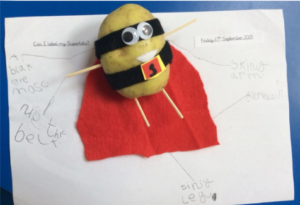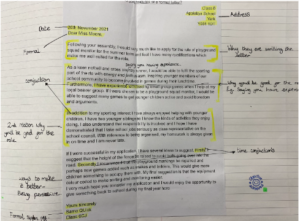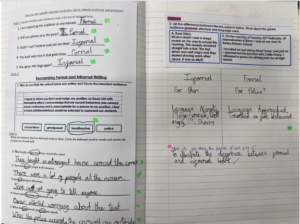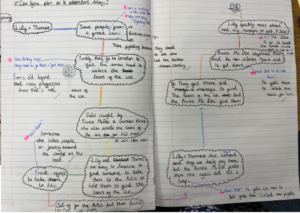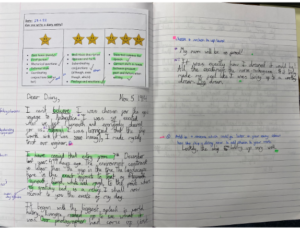Writing Sequence of Learning:
At Osbaldwick we want to encourage a culture of creative writing where children feel proud of their work.
Substantive Knowledge
We believe that a secure foundation in basic transcription skills is crucial to progression in writing. This is because if a writer has mastered transcription, they can then focus their attention on developing, organising and communicating their ideas. This is why at Osbaldwick the transcription skills of spelling and handwriting are taught separately. In these lessons, children are shown how to segment a whole word into its individual sounds (phonemes) and then to identify which graphemes can represent the separate phonemes. Alongside this, they are taught key spelling rules and common exception words. Children are also tutored in handwriting, being shown how to form letters of the correct size and orientation. They then have the opportunity to repeatedly practise this until they become fluent. Grammar and punctuation are explicitly focused on in separate lessons as well so that, when ready, the focus of a piece of writing can be on composition (articulating and structuring of ideas) and not basic transcription.
Disciplinary Knowledge
We use a five part sequenced approach to teaching writing across the school which allows children to develop a deeper understanding and gives them the opportunity to apply their transcription skills in context.
First we ‘Immerse’ the children in the piece – this could be through a practical activity such as making something, it could be through role play or through the use of multimedia. The aim is that the children are engrossed and enthused in their task and understand the purpose of what they are going to be writing about, who their audience is and why they are writing it.
The second step is ‘Analyse’– this is where we study a good example of what a piece should look like. Again this is done in a number of ways, it could be focusing on a good example and unpicking the reasons why it is good, it could be comparing different examples and stating our preference or it might be working as a class to enhance one together.
After analysing, we choose a ‘Skill’ that we will need to apply in our writing in order to produce a successful piece. This could be, for example, commas in a list, use of adverbial phrases or creating an atmosphere through word choice. We practise this skill in a number of ways to help us feel more confident so we will be able to apply it in our own piece of writing.
After practising our skill, we start to ‘Plan’ our piece of writing. Again this is done in a number of ways such as through a planning grid, a story mountain or more of a creative approach. We ensure that this stage is given plenty of time in order to help children scaffold their ideas so they do not feel overwhelmed when it comes time to ‘put pen to paper’.
Now the children have all the tools they need to ‘Write’ their final piece. We ensure that we provide them with modelled or shared writes to help guide them along their journey. They also have the 3 star checklist or picture checklist in KS1 so they are reminded of what they need to include in their piece. The children are encouraged to celebrate their writing and share their ideas with the rest of the class during these sessions.
Finally, we encourage children to ‘Edit’ their work to make it the best it can be. We use a double page spread whereby children write their first draft on the left hand side of the paper, the right hand side is used for editing- either adult-driven or self editing as the children become more familiar and confident with how they can improve their own work.


